Table of Contents
Introduction
Running Shoes Market Dynamics
How to Select
the Best Running Shoes
Conclusion
Introduction
In the dynamic world of athletic footwear, the evolution of running shoes stands as a testament to innovation and consumer-driven design. As we step into 2024, the landscape is more diverse and technologically advanced than ever, making the selection of the right pair crucial not just for individual performance and comfort but also for savvy business professionals and online retailers who cater to a discerning market.
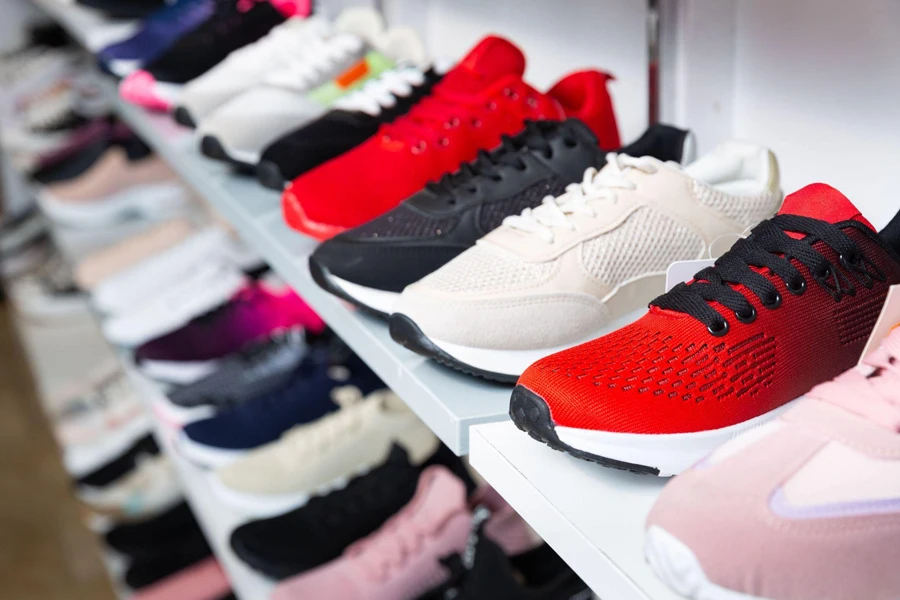
Running Shoes Market Dynamics
The market size of running shoes in North America is part of the broader athletic footwear market, which is projected to grow at a Compound Annual Growth Rate (CAGR) of 3.45% by 2027. The global running shoes market was valued at USD 15.44 billion in 2021 and is expected to grow at a CAGR of 4% from 2022 to 2030. The market for running shoes in North America is expected to dominate with a market share of approximately 40%.
Key players shaping this market include Puma SE, Adidas AG, Nike, Under Armour and Asics Corporation, known for their innovative product designs and substantial marketing strategies. These brands have been instrumental in driving consumer preference through a combination of technological advancements and design aesthetics, catering to diverse consumer needs. For instance, On Running had a 62% year-over-year growth, Hoka had a 59% growth, and Nike was estimated to have around 20% of the running footwear market.
How to Select the Best Running Shoes
In the dynamic world of athletic footwear, selecting the right running shoes is pivotal for both individual performance and retail success. 2024 brings a variety of options, each catering to different needs and preferences. This section delves into the essential factors to consider when choosing running shoes, drawing on insights from credible sources in the sports footwear industry.
Shoe Type: Trail, Road, or Hybrid
Trail Running Shoes
- Designed for rugged, off-road conditions, trail running shoes feature beefier outsoles with bigger, softer lugs for enhanced traction on trails. This is crucial for navigating over rocks, roots, and uneven terrain.
- Their midsoles are typically stiffer, providing a more stable platform on uneven surfaces. Some even include rock plates for additional protection against sharp objects.
- The uppers of trail shoes are reinforced for added protection from trail debris. This rugged construction is essential for durability in harsh trail conditions.
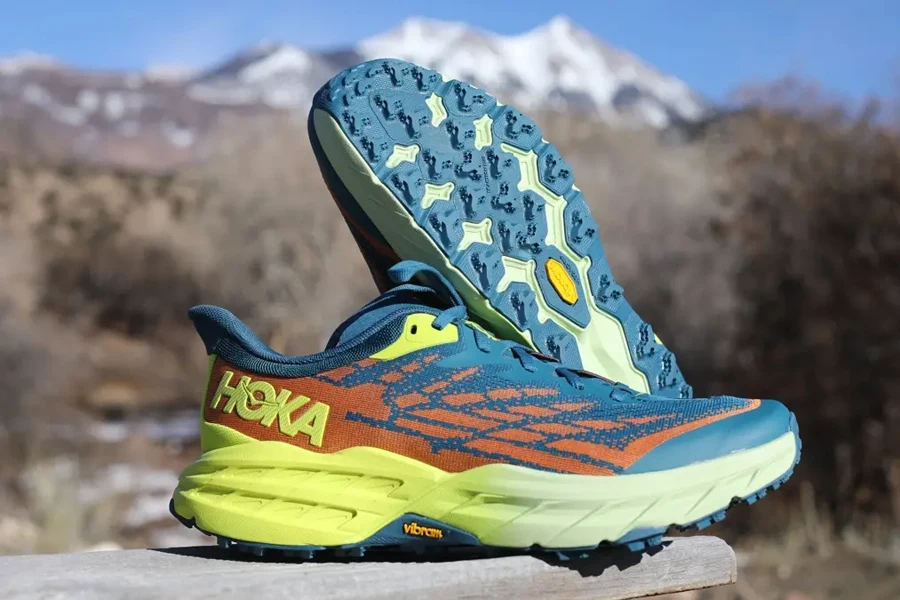
Road Running Shoes
- Road running shoes are optimized for pavement and smoother surfaces. They have flatter, smoother soles with durable rubber that withstands frequent contact with hard pavements.
- Their midsoles are generally softer, offering cushioning necessary for the repetitive impact of road running. This design aids in shock absorption and comfort over long distances.
- The uppers on road shoes focus on being lightweight and breathable, as they don’t require the same level of protection and reinforcement as trail shoes.
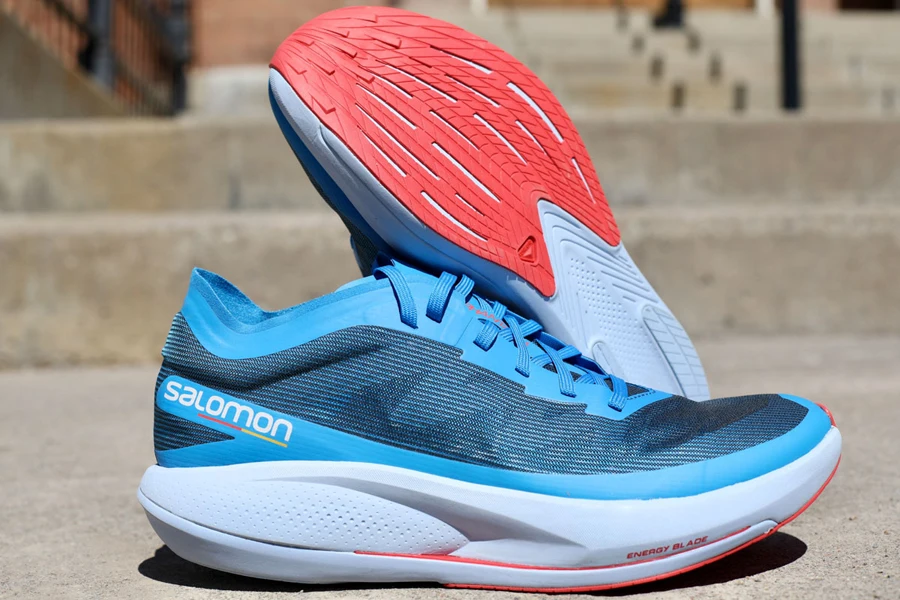
Hybrid Running Shoes
- Hybrid running shoes strike a balance between trail and road designs, suitable for runners who frequently transition between different terrains.
- These shoes blend the protective features and traction of trail shoes with the cushioning and lightness of road shoes.
- They are versatile, offering a solution for varied running environments without the need for multiple specialized pairs.
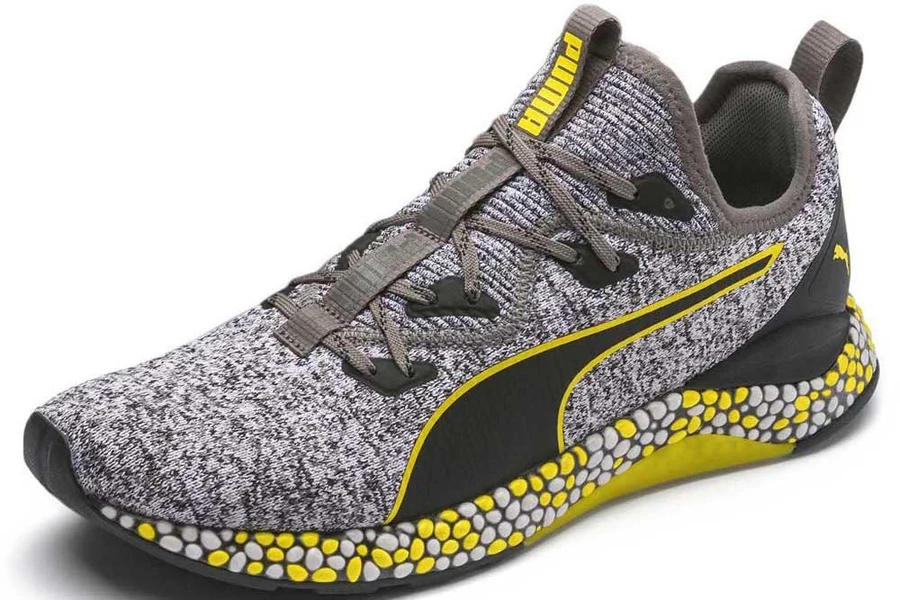
Basic Structure of a Running Shoe (Technology, Materials and Design):
Upper: The upper part of the shoe encloses the foot, acting as a protective and stabilizing element. The part is often made from a blend of synthetic materials, mesh, and occasionally leather. Synthetic materials and mesh are preferred for their breathability, flexibility, and lightweight properties. These materials allow for adequate air circulation, keeping the feet cool and reducing moisture accumulation. The upper is designed to firmly hold the foot in place, reducing internal slippage and aligning with the foot’s natural anatomy. In some running shoes, the upper incorporates water-resistant or waterproof materials, making them suitable for running in wet conditions.
Toe Box: The front part of the shoe provides space for the toes. Designed to be roomy enough to allow for natural toe spread during running, which is essential for proper balance and propulsion. Typically made from flexible and durable materials that can accommodate the movement and expansion of the toes as the foot strikes and pushes off the ground. The toe box area is designed to work in conjunction with the midsole and insole to provide a balanced and responsive feel during the toe-off phase of the running gait. It also aims at providing a comfortable, non-restrictive fit while ensuring adequate protection and durability to withstand the repetitive impact of running.
Heel Counter: The heel counter is a semi-rigid, U-shaped piece that snugly wraps around the heel, extending over the shoe’s upper heel portion and often including sidewalls beneath the medial and lateral malleoli. It’s crucial for stability as it locks down the rearfoot. This design greatly improves fit and comfort around the heel area, effectively preventing heel slippage, which is particularly important during uphill running. The heel counter also maintains the shoe’s shape and ensures its durability over time.
Different types of heel counters used in running shoes can be categorized into three main groups: no heel counter, average or soft heel counter, and stiff heel counter.
- No Heel Counter: Some shoes, particularly those designed for racing, do not have heel counters to reduce weight. These shoes tend to be very flexible at the heel.
- Soft Heel Counter: Common in many daily trainers and speed training shoes, soft heel counters strike a balance between comfort and heel lockdown.
- Stiff Heel Counter: Often found in stability running shoes, stiff heel counters are essential for runners with overpronation. They provide a high level of support and restrict excessive foot movement.
- Internal vs. External Heel Counters: Internal heel counters are embedded within the shoe and hidden by the upper, often made from flexible, low-cost materials like cardboard or plastic derivatives. External heel counters, visible on the outside of the shoe, are typically stiffer and crafted from materials like Thermoplastic Polyurethane (TPU).

Midsole: The midsole, situated between the upper and outsole of a shoe, is crucial for cushioning and shock absorption. It commonly employs materials like lightweight and cushioning EVA (Ethylene Vinyl Acetate) or durable and stable PU (Polyurethane). Innovations like composite cushioning blend foam, gel, and air for superior shock absorption and energy return. The midsole’s design is tailored to the shoe’s purpose: running shoes feature enhanced cushioning for impact forces, while cross-training shoes balance cushioning with stability and flexibility for diverse exercises. Future midsole technologies aim to boost efficiency and speed, enhancing athletic performance.
Outsole: Outsoles of running shoes are primarily crafted from rubber variants like durable carbon rubber, used in high-wear areas, and softer, more cushioned blown rubber for better traction and flexibility. The outsole’s design varies with the shoe’s purpose: trail shoes have aggressive lug patterns for grip on rough terrains, while road shoes feature flatter soles for hard surfaces. Features like flex grooves and split-heel designs enhance natural foot movement and flexibility. Tread patterns are optimized for grip and stability, crucial in different conditions. Some shoes incorporate TPU (Thermoplastic Polyurethane) for reinforced durability without added weight, and eco-friendly materials like recycled rubber are increasingly used for sustainability.
Insole: Insoles, made from materials like EVA, PU, gel, or memory foam, are designed to suit various foot types and running needs. They range from flat, thin insoles for basic cushioning to contoured ones offering arch support and heel cradling. Some are specifically tailored for conditions like plantar fasciitis, with targeted support. Many running shoes feature removable insoles for customization with orthotics, and advanced options like 3D scanning technology enable personalized support. Insoles are vital for comfort, weight distribution, and injury prevention, also assisting in managing foot conditions. Recent developments include sustainable insoles crafted from recycled or bio-based materials.
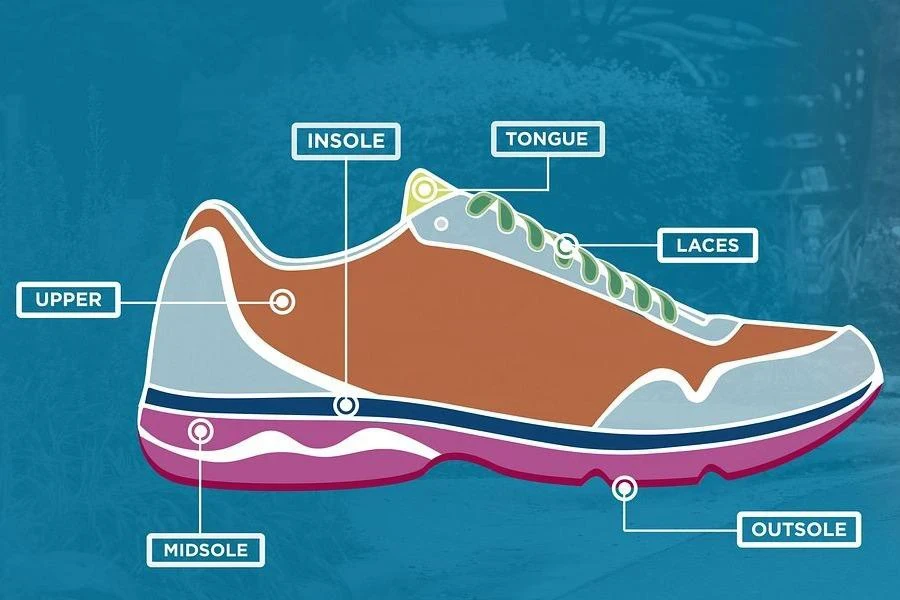
Lacing System: Laces are typically made from durable synthetic materials designed to withstand the stress and environmental conditions of running. Variations include flat laces, which are less prone to untying, and round laces, which may offer more flexibility and comfort.Recent advancements include integrated lacing systems that connect the laces to the midsole or sole of the shoe, providing a more dynamic fit that adjusts as the foot moves. Some high-tech running shoes even offer smart lacing systems that can automatically adjust the tightness based on the runner’s activity or foot pressure data.
Types of Lacing Techniques and Adjustments:
Standard Lacing:
- The most common technique, where laces are crisscrossed evenly.
- Offers a balance between snugness and comfort.
Heel Lock or Lace Lock:
- Creates extra friction near the ankle to prevent the heel from slipping out.
- Ideal for runners who experience heel slippage or want a tighter fit around the ankle.
Gap Lacing or Window Lacing:
- Skips crossing the laces over sensitive areas, often used to relieve pressure on the top of the foot or accommodate a high arch.
- This technique creates a small “window” or “gap” in the lacing.
Loop Lacing Lock or Bunny Ears:
- Helps in tightening the shoe and providing a custom fit.
- Involves creating loops with the laces and threading them through each other.
Diagonal Lacing:
- Laces are threaded diagonally across the shoe, skipping alternate eyelets.
- Useful for people with a wide forefoot or those who need more room in the toe box.
Extra Eyelet Lacing:
- Utilizes the extra eyelets near the top of the shoe to secure the foot and prevent forward movement.
- Especially beneficial for downhill running.
Parallel Lacing or Straight Bar Lacing:
- Laces run straight across the shoe without crisscrossing.
- Offers a pressure-free fit, suitable for wide feet or high insteps.
Asymmetrical Lacing:
- Adjusts the lacing pattern to follow the natural asymmetry of the foot.
- Addresses issues like side-specific pressure points or foot alignment problems.
Lacing for Toe Pain or Toe Numbness:
- Adjusts tension around the toe area to alleviate pressure.
- Helpful for runners who experience toe pain or numbness.
High Instep Lacing:
- Alleviates pressure on the instep by spreading the laces wider apart in the middle of the foot.
- Beneficial for runners with a high instep or a prominent arch.
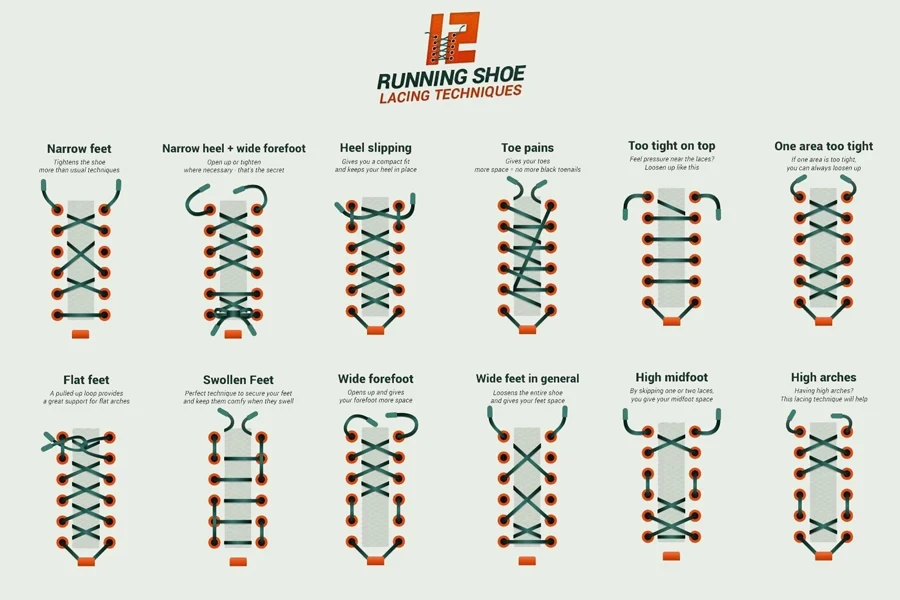
Tongue: The tongue of a running shoe, situated between the laces and foot at the shoe’s opening, is made from soft, flexible materials like leather, fabric, or synthetics for comfort and cushioning. It’s securely attached to the upper, often with gussets for adaptability to various foot shapes and sizes. Padded or lined for extra comfort, the tongue evenly distributes lace pressure. Its design varies with the shoe type: low-cut shoes have shorter tongues for flexibility, while high-tops feature longer, padded tongues for additional support and protection.
Collar/Ankle Support: The collar of a running shoe supports the ankle and heel, ensuring stability and preventing foot slippage, crucial for balance and avoiding ankle injuries. Made from soft, padded materials like foam, synthetic fabrics, and sometimes gel or silicone, it offers comfort and prevents chafing. The collar’s height and padding vary with the shoe type: running shoes typically feature moderate padding for a balance of support and flexibility, while trail or hiking shoes have a higher, more robust collar for added ankle support and debris protection. The collar, along with the shoe’s tongue, plays a significant role in foot health, comfort, and distributing pressure, influencing the shoe’s fit, running efficiency, and comfort.
Fit and Comfort:
Size and Length:
- Shoes should have about a thumb’s width of space between the longest toe and the front of the shoe to accommodate foot swelling during running and to prevent toe injuries.
- It’s common for runners to choose shoes a half to a full size larger than their regular street shoes.
Width:
- The shoe should fit snugly but not tightly across the widest part of the foot (the ball).
- Runners with wider feet might need to look for shoes offered in wide or extra-wide options.
Arch Support:
- The shoe should comfortably support the natural arch of the foot.
- Runners with flat feet may require more structured arch support, while those with high arches might need more cushioning under the arch.
Heel Fit:
- The heel should fit securely with minimal slippage.
- A good heel fit prevents blisters and provides stability.
Toe Box:
- The toe box should allow toes to spread naturally without feeling cramped or restricted.
- Adequate room in the toe box is essential for balance and proper toe-off during the stride.
Flexibility and Responsiveness:
- The shoe should flex at the forefoot to match the foot’s natural bending point.
- It should also provide a responsive feel, returning energy to the runner.
Cushioning:
- Appropriate cushioning for individual needs can significantly enhance comfort.
- The right amount of cushioning depends on personal preference, running style, and the type of terrain.
Breathability:
- Upper materials should allow for good air circulation to keep feet cool and reduce moisture build-up.
Insole and Orthotics Compatibility:
- For those who use orthotics or prefer specific insoles, it’s important to check how they fit within the shoe.
Overall Feel:
- The shoe should feel comfortable from the start, without a significant break-in period.
- Comfort should not be sacrificed for style or other features.
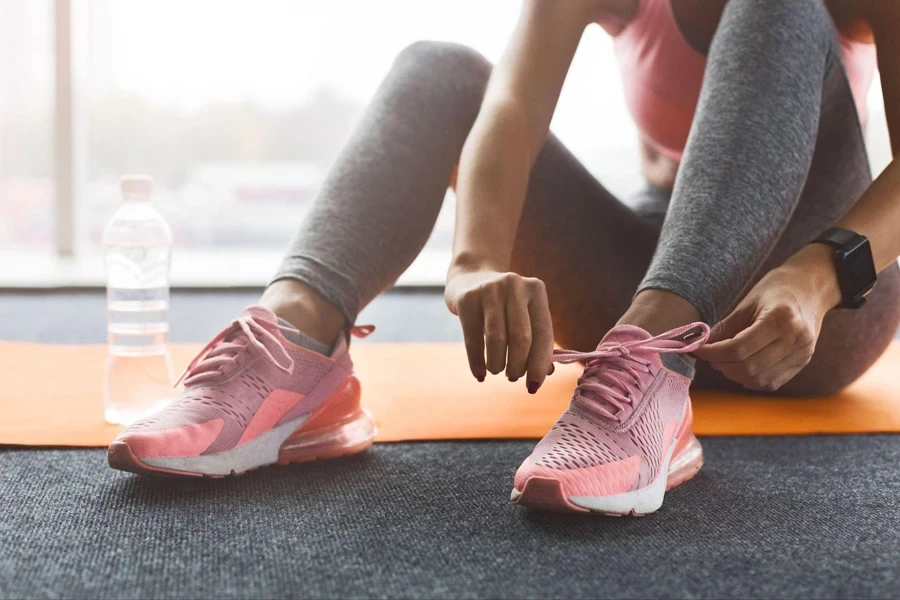
Cushioning Levels:
Minimal Cushioning:
- Minimalist shoes that offer the least cushioning.
- Designed to mimic barefoot running, providing a natural ground feel.
- Typically have little to no arch support and a low heel-to-toe drop.
- Ideal for runners who prefer a more natural running experience and have a strong, injury-free running form.
Light Cushioning:
- Offer a balance between a barefoot feel and some cushioning.
- Suitable for runners who want a bit of protection without excessive padding.
- Often used for faster-paced running or racing where a lighter shoe is advantageous.
Moderate Cushioning:
- The most common cushioning level, providing a balance of comfort, support, and responsiveness.
- Suitable for a wide range of runners, including those who run on mixed terrain or need a versatile shoe for different types of workouts.
- Offers enough cushioning for comfort while still allowing for good ground contact.
High Cushioning:
- Shoes with enhanced cushioning for maximum shock absorption.
- Ideal for long-distance running, providing extra protection and comfort over extended periods.
- Often favored by heavier runners or those who prefer a plush, comfortable ride.
Maximum Cushioning:
- The highest level of cushioning available in running shoes.
- Often features thick midsoles made from soft, responsive materials.
- Provides exceptional shock absorption and comfort, reducing strain on joints and muscles.
- Suitable for ultra-distance runners or those who prioritize comfort over speed.
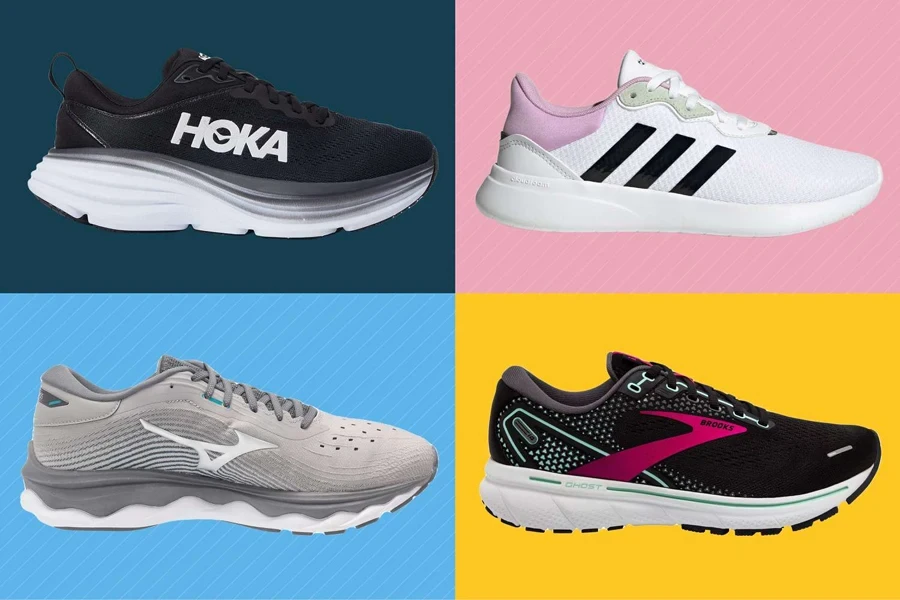
Conclusion
The 2024 running shoe market showcases significant advancements across various categories, including trail, road, and hybrid models. These shoes feature innovations in traction, cushioning, and versatility, catering to the diverse needs of runners from rugged terrains to urban pavements. For retailers and sports professionals, understanding these trends is key to meeting consumer demands. This year’s developments highlight the importance of selecting the right shoe for enhanced performance and injury prevention, reflecting the industry’s commitment to catering to the evolving needs of runners.



